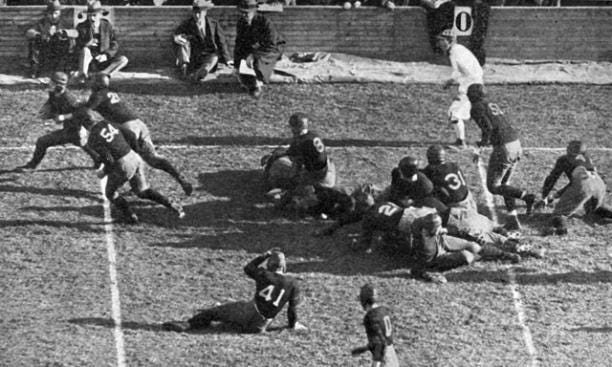Today's Tidbit... Dirty Play And A Ring Of Truth
Back in the day, there was an element of chivalry in football. Despite many stories of dirty play, there were other tales of teams tackling opposing players high due to the awareness that an opposing player had a leg injury. For example, an earlier Tidbit mentioned the story of Clemson's Don King earning a 1953 sportsmanship award for telling his team to avoid hitting the Wake Forest quarterback's injured knee.
A similar event occurred when Davis & Elkins played Army in 1925. Army entered the game with one of its three quarterbacks in the hospital. When the starter became dazed in the second quarter, he left the game until his replacement was injured, forcing Army to send the starter back in. Army's trainer advised the Davis & Elkins captain of the situation, leading him to gather his team and instruct them not to mistreat Army's quarterback. They followed his instruction, which allowed Army's quarterback to finish the game without incident.
Of course, teams don't always follow the chivalrous path, which supposedly was the case when Harvard and Princeton battled in 1926, and Princeton won for the third year in a row. Things got heated the morning of the game when the Harvard Lampoon published a story that Princeton coach Bill Roper had died, much to Roper's surprise.

When the team took the field, Princeton played aggressively in the 12-0 win that saw six Harvard players leave the game due to injury. The Lampoon story and injuries added to the bad blood between the two schools, resulting from Princetoln's desire for the Big Three (Harvard, Yale, and Princeton) to rotate the season-ending game rather than Harvard and Yale always playing one another. Princeton-Yale had been the big game until the late 1890s, after which Harvard-Yale became the traditional matchup.
A few months after the game, a Harvard player from the 1919-1920 era, Wynant Hubbard, penned a magazine story indicating that Princeton had deliberately attempted to injure Harvard players in the game. One piece of evidence was Harvard fullback Al Miller leaving the game with P emblazoned on his nose from a Princeton player's signet ring.

The branded nose story may have been fictitious, but sparks and words flew for a few weeks before fading away, so there may have been a ring of truth to the story. There is one undisputed fact, however. Harvard and Princeton did not meet on the football field for another eight years, so somebody wasn't happy about the relationship, whatever the underlying reasons.
Football Archaeology is reader-supported. Click here to buy one of my books or otherwise support the site.



Oh this is definitely a future podcast subject post. Great story and well done research.